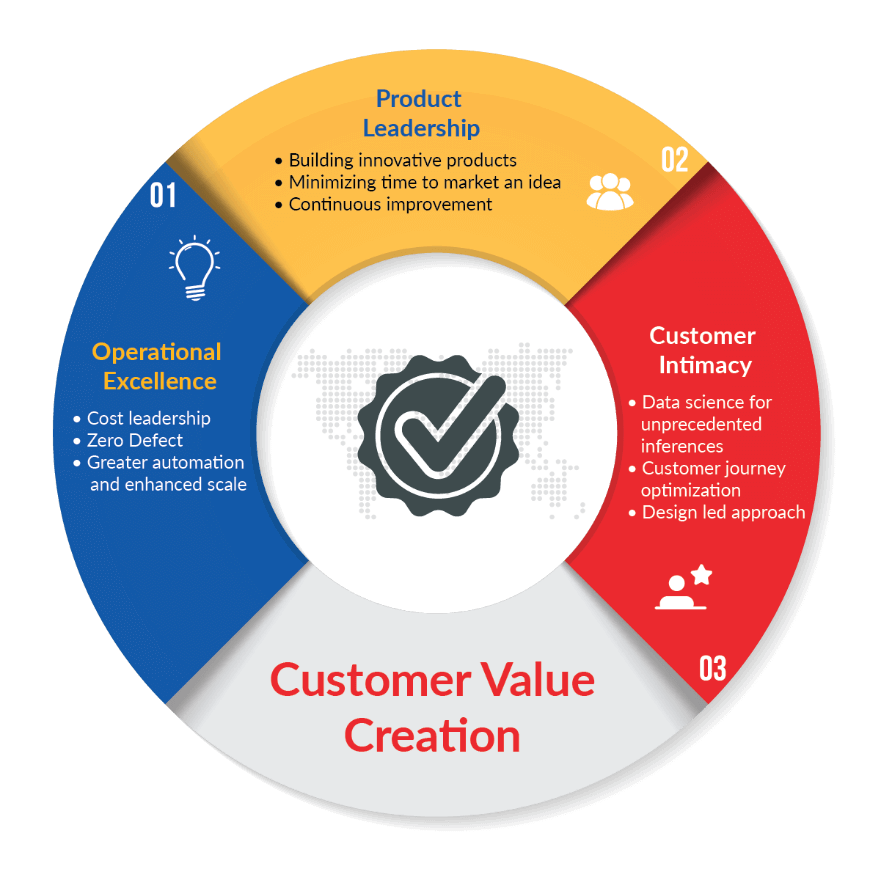Faced with the challenges of bringing together diverse and complex technologies in the new-age milieu governed by the digital world, enterprises often fumble when it comes to delivering consistent and superior customer experience. In today’s digital world, customers can control their interactions with business, and expect ready access to personalized and contextual information, at anytime, anywhere and in their preferred format. One defining aspect in this dynamic and disruptive business environment, is to deliver amazing customer experience. In this blog, lets explore the three cornerstones of value disciplines and Hexaware’s take on it.
There are dozens of IT services companies around the world that we compete with today. Many of them, like us, have a full range of IT and IT-enabled services to offer. Application development and maintenance, infrastructure and cloud, testing services, BPO, digital and analytics, artificial intelligence, machine learning, robotic process automation are services that appear on every website. Similarly, verticals we support; banking, insurance, manufacturing, telecom, transportation, are not unique either. In such a scenario, a key question that we need to answer is, how are we different? Why should a client select us over the others?
The answer lies in articulating why we are in business. Making money alone cannot be an objective. As Simon Sinek, a British-American marketing consultant famously quoted that customers usually buy from an organization not because of what they do or how they do it, but because of ‘why’ they do it. Average to good brands spend most of their time articulating ‘the what’ and ‘the how’. However, the truly great ones have a well-articulated, inspiring mission, a reason for their existence, a significant competitive advantage which defines why they are in business.
Disney is in business to make customers happy. The theme parks, and the films are ‘the what’ and ‘the how’. Google is in business to organize the world’s information and to make it universally accessible. YouTube, maps, search comprise of the what and the how. Similarly, Nike wants to bring inspiration and innovation to every athlete in the world. Walmart wants to help people save money. Facebook aspires to bring the world closer together. And Intel’s mission is to bring smart, connected devices to every person on earth.
This core purpose, in turn defines the culture of the organization. One recruits and retains talent that identifies and aligns with this core purpose. Everyone rallies around it. Investments are prioritized against this goal. The structure of the organization, the compensation and reward philosophy too are guided by this. Even clients that we target and partner with, are the ones who identify with and are excited by this mission.
So, what’s our raison d’être? What binds us and what drives us? Let’s spend some time discussing this.
Customer Value Creation: The Three Cornerstones

Our clients are competing for customers in their respective industries. The general belief is that delivering value to its customers is what will help them attract and retain customers. An HBR article published nearly twenty-five years back, defined three value disciplines that enable customer value creation. These disciplines are Operational Excellence, Product Leadership and Customer Intimacy.
Most companies that have taken leadership positions in the last three decades, did so by excelling in one of these values, while meeting a base standard in the other two values. The number of companies that managed to excel in two of these values are just a handful, while almost no company managed to excel in all three.
The reason is very straightforward. A company’s core purpose determines which of these value disciplines will be the differentiator. So, the culture of the organization has to be built around this mission and discipline. It is tough to build a culture that is driving focus on more than one of these disciplines. Also, all investments have to be channeled towards excelling in the chosen discipline. It is tough to find a company that has adequate margins and bandwidth to be able to invest in excelling in more than one. Most successful companies succeed by narrowing their focus rather than broadening it.
The ‘Big’ Shift in Focus:
Now as we look around, there are numerous examples of companies that have succeeded through focus on operational excellence and product leadership.
Operational Excellence
Operational excellence manifests itself in the form of low costs, and through ‘zero-defect”. Reliance Jio is an example of success through primarily cost leadership. Numerous budget airlines are the result of successful adoption of operational excellence. Chinese mobile phones too are great examples in this category We anticipate more companies to follow this path to leadership, with greater robotic process automation.
Product Leadership
The second discipline is product leadership. This involves building products that sell for their innovative features and ease of use. Not just that, such a company has to keep producing a steady stream of innovative products. Some of them could be continuous improvement over what they have already created, while others could be products that solve new problems. Processes are geared towards minimizing the time to market an idea. Apple is a classic example. The company continues to create generation after generation of iPhones, each better than the previous. They also keep producing new product lines; iPad, Apple TV, Homepod.
Customer Intimacy
The third discipline is excelling in customer intimacy. This requires micro-segmentation and customizing the offering. A bespoke quality of service has to be provided. Home Depot is one of the few companies that comes to mind, that continues to excel in this discipline. This is the toughest discipline to excel in and that is why we do not see too many examples of leadership in this space. Meanwhile, it’s not hard to understand why.
Delivering on customer intimacy, as a differentiating factor, had a huge dependency on people in the past. Delivering consistency in people dependent interactions (bank branches / retail stores / field sales force / contact centers) was a challenge. Data analytics and data sciences were not strong enough to analyze and predict buyer behavior. Applications developed using “water-fall” methodology, took too long for enhancements. Even as commerce started going online, scalability of processing power and storage would often become bottlenecks to provide consistency of experience. Testing of systems was largely manual and limited in its ability to provide quality assurance quickly. All this combined was too much of a challenge to deal with. Companies found it easier to focus on operational excellence and product leadership.
The Coming Era of Customer Intimacy
All these bring to us a unique opportunity that companies across industries can exploit today. Customer intimacy and customer experience are the key differentiating factors that companies today can adopt. Many limitations of the past do not exist anymore. Data science provides us unprecedented insights into consumer preferences at a more granular level. These insights can be used for micro-segmenting customers to a segment size of one. And that is the design challenge. With the advent and evolution of digital channels, there is an opportunity to customize touch points as per the consumer needs. Applications and ERP systems can be rapidly improved using agile frameworks, to feed and support these channels. Adoption of the cloud, provides the required processing power and the required storage, on demand. Automation in testing allows speed, scale and rigors of testing hitherto deemed impossible. And once again, data sciences allow us to keep improving with successive iterations of this cycle.
Customer Experience Transformation process with Hexaware
Hexaware, a consistently ranked Everest Group’s PEAK Matrix Service Provider of the Year™ 2018, is uniquely positioned to partner with its clients on this customer journey optimization. We pride ourselves in having the ‘world’s happiest customers’, scoring top industry level scores on key parameters like loyalty, advocacy, satisfaction and value for money, as per an independent consulting and research firm.
Our Approach:
- Hexaware’s Customer Experience Design harnesses ‘experience first methodology’ that brings together Design Thinking, Systems Thinking, User Centered Design, data sciences, Lean UX and customized delivery, throughout the lifecycle of the project
- Conversational UIs enable bots to imitate human agents on any interface through fast, effective and low-cost engagement of your target customer
- Transitioning smoothly from heterogenous legacy systems to high-performance modern platforms, powered by our data management best practices, innovative tools and technology
- A design-led approach allows us now to stitch these capabilities together, to help our clients build customer experience strategy as a differentiator and a competitive advantage
Hexaware has experience in delivering individually, these components for multiple clients across numerous industries.
Highlighting below our best case studies, in customer experience transformation.
- Contact Center Transformation for the Second Largest Telecom Company: For a leading Telecom operator, Hexaware helped in improving critical customer centric parameters like reducing the churn rate from 2.3% to 0.75% and in maintaining consistent CSAT score of 96% on back o¬ffice resolution
- Transforming the Customer Experience for Asia’s Largest E-commerce Player: For a leading retailer, Hexaware helped in addressing customer experience gaps and in optimizing customer experience, resulting in quality scores from 65% to 81%, in less than 2 months
Our focus is on helping enhance and integrate diverse systems, and improve performance and scalability through Cloud, for multiple clients, across diverse industries. Customer intimacy is one of the important avenues and a key cornerstone strategy, that helps us in achieving product excellence.
Hexaware has decided to take a leadership position in helping our clients go through this customer experience transformation journey. Our mission is to help our clients create customer intimacy as their competitive advantage. It’s a unique opportunity for our clients and for us.


















